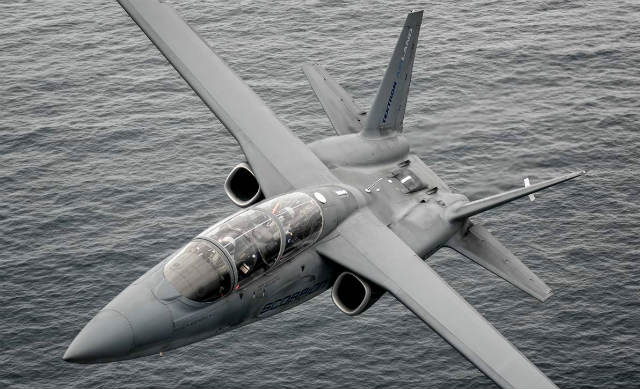Textron AirLand has released details about recent demonstration flights performed in support of the UK Royal Navy using its Scorpion light strike and surveillance platform.
During a series of around eight flights, the Scorpion was tasked with inspecting maritime surface contacts by observers aboard a Westland Sea King 7 airborne surveillance and control helicopter from 849 NAS, based at Culdrose in Cornwall.
“Royal Navy crews were able to use the Scorpion for valuable controller experience, while Textron was able to put the recently integrated Thales I-Master radar through its paces in a maritime environment,” the US company says. The aircraft’s L-3 Wescam MX-15 electro-optical/infrared sensor was also employed during the activity.

Lloyd Horgan/Textron AirLand
With a typical endurance of 3.5h, the flights were staged from the Ministry of Defence’s Boscombe Down site in Wiltshire. Six staff pilots from the Empire Test Pilots’ School – which operates from the same location – were also given the opportunity to fly the type.
The Scorpion team had remained in Europe following the aircraft’s appearance at last month’s Paris air show, also supporting demonstrations conducted in Bulgaria and Romania.
Referring to the Scorpion’s high reliability rate, Textron AirLand chief test pilot Dan Hinson notes: “We’ve only put gas in since we left Kansas”, with “zero unscheduled maintenance” required. A total of 451 flight hours had been accumulated using N531TA on its arrival at the Royal International Air Tattoo (RIAT) at RAF Fairford in Gloucestershire, with 39h having been flown since the Paris show.
In addition to the I-Master synthetic aperture radar payload’s installation, other recent enhancements have included the fitment of an airbrake and improved anti-skid braking capability, plus anti-icing system equipment, Hinson told Flightglobal at RIAT.

Lloyd Horgan/Textron AirLand
In the rear cockpit, a single-panel, 15in-wide multi-function display has enhanced the working environment for a sensor operator, with a stowable keyboard also used during the demonstration with the RN.
“We’re looking for legitimate ISTAR [intelligence, surveillance, target acquisition and reconnaissance] capability,” says Hinson. “We needed a display to show it.”
The Scorpion began the return flight to its home in Wichita, Kansas, on 20 July, with the Flightradar24 tracking service recording it as having completed legs to Stornoway in the Outer Hebrides and Keflavik in Iceland. Further stops are scheduled in Greenland, Canada and the USA before the completion of its journey.
A second-generation version of the Scorpion is due to be rolled out in the second quarter of 2016, and Hinson says he “cannot wait” to take the controls.
Enhancements will include the use of trimmable horizontal stabilisers, a trailing link main undercarriage and slightly rounder engine intakes. The aircraft’s wing has also been swept back by a further 4˚, and a wider nose will enable an air-to-air radar to be fitted, along with a weather radar, Hinson says.
The programme’s first aircraft will continue to be operated in support of tasks including mission system and weapons testing; the latter of which will commence later this year with loading and flight trials.
After its return to Wichita, the current aircraft will support remaining “clean-up” testing, along with validating a few remaining parts of the twin-engined type’s performance envelope, says Hinson.
Source: FlightGlobal.com
















